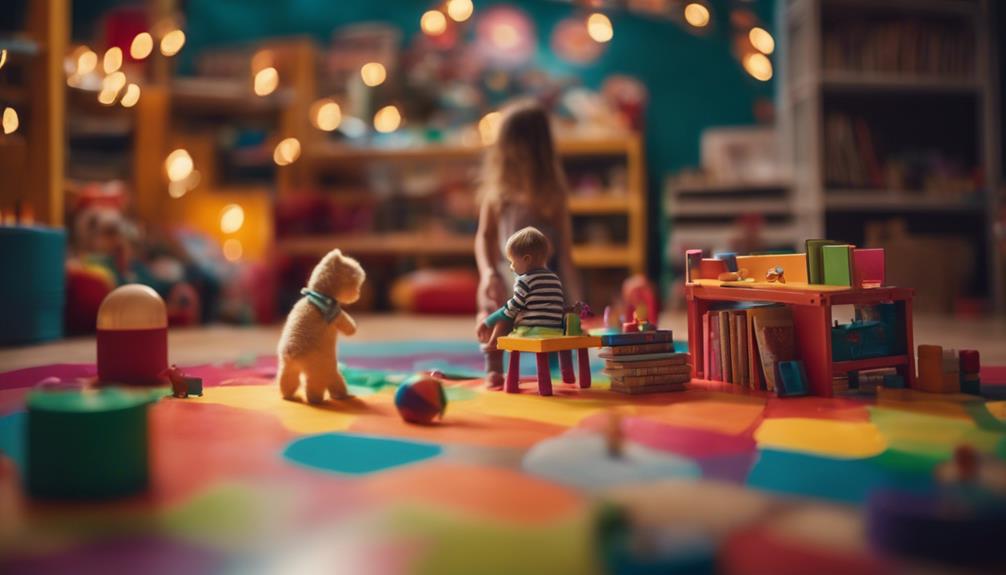To ensure a baby’s happiness, focus on developing emotional connections through skin-to-skin contact, responsive caregiving, interactive play, and creating a nurturing environment. Be attentive to their signals like crying and cooing, observe their expressions and body language. Create an engaging setting with sensory activities, toys suitable for their age, and interactive play. Promote laughter, affection, and positive emotional interactions. Provide comfort with a good sleep environment, proper nutrition, appropriate clothing, and hygiene. Keep track of developmental milestones and participate in activities suitable for their age. By following these guidelines, you can establish a solid base for your baby’s happiness and well-being.
Key Takeaways
- Skin-to-skin contact and responsive caregiving for emotional bond.
- Prompt response to cues and recognizing signs of hunger or discomfort.
- Engage in interactive play for positive emotional experiences.
- Ensure a nurturing, stimulating environment with age-appropriate toys.
- Encourage laughter and affection for joy and well-being.
Importance of Bonding and Interaction
To make a baby happy, prioritize bonding and interaction through skin-to-skin contact and responsive caregiving. Skin-to-skin contact isn't just about physical closeness; it plays an essential role in emotional bonding between you and your baby. This practice reduces stress levels for both of you, creating a secure attachment that fosters a sense of safety and comfort.
Promptly responding to your baby's cues is another critical aspect of building this bond. By making eye contact, talking, and singing to your little one, you're establishing a strong connection based on trust and understanding.
Furthermore, engaging in interactive games like peek-a-boo and gentle tickling can bring moments of joy and laughter, deepening the emotional bond you share with your baby. Carrying your baby close to you in a baby carrier or wrap enhances this bond by providing a sense of security and warmth.
Creating a nurturing environment filled with affection, interaction, and attentive care is essential for your baby's overall well-being and development. Building a strong bond through these interactions sets the foundation for a happy and healthy relationship between you and your little one.
Responding to Baby's Cues

When a baby cries, it's their way of telling you something isn't right. Reading their signals promptly and responding with care is essential.
Reading Baby's Signals
Make sure to respond promptly to your baby's cues such as crying, cooing, or reaching out to build trust and strengthen the bond.
Pay close attention to your baby's facial expressions, body language, and sounds to understand their needs and emotions.
Babies often communicate through non-verbal cues like eye contact, gestures, and movements, which can provide valuable insights into their feelings and desires.
By recognizing signs of hunger, tiredness, discomfort, or overstimulation, you can effectively address your baby's needs.
Responding consistently to your baby's signals is vital in creating a secure and nurturing environment that promotes their emotional well-being.
Understanding your baby's needs through reading their signals not only fosters a strong bond but also helps in establishing a sense of security and trust.
Establishing Trust
Responding promptly to a baby's cues is essential for establishing trust and building a secure attachment with your little one. When you respond promptly to your baby's cries or signals, you're showing them that you're there for them, which helps in creating a sense of trust.
Babies rely on caregivers to provide comfort and relief, and by responding to their needs, you're reinforcing the caregiver-baby bond. Direct eye contact while interacting with your baby can help them feel emotionally connected to you, further solidifying the secure attachment they've with you.
By recognizing and responding to your baby's cues, you're letting them know that their needs are understood and valued, creating a safe and secure environment for them to thrive in. Trust is built over time through consistent and loving responses, fostering a sense of well-being and security in your baby.
Promptly Meeting Needs
Meeting your baby's cues promptly is vital for ensuring their needs for comfort and security are met effectively. When you respond promptly to your baby's cues, you provide them with the emotional comfort they seek, fostering a strong bond and sense of trust between you and your little one.
Studies have shown that these prompt responses play an essential role in developing a secure attachment and overall happiness for your baby. Ignoring your baby's cues can lead to feelings of distress and insecurity, hindering their emotional development and well-being.
Stimulating Environment for Development

To create a stimulating environment for your baby's development, engage in sensory activities that expose them to various sounds, textures, and colors.
Providing age-appropriate toys and safe spaces for exploration can enhance cognitive growth and learning.
Remember to prioritize interactive play that encourages physical activity, curiosity, and creativity to foster a well-rounded developmental experience.
Engaging Sensory Activities
Enhance your baby's sensory development by engaging them in stimulating activities that explore different textures, sounds, and colors. Here are some tips to create a sensory-rich environment for your little one:
- Textured Toys: Introduce toys with various textures to stimulate your baby's sense of touch and encourage exploration. Textured toys can help in developing fine motor skills as babies grasp and feel different surfaces.
- Sensory-Rich Environment: Incorporate different sounds, colors, and textures in your baby's surroundings to promote sensory development. This exposure to sensory stimuli can aid in cognitive development by engaging multiple senses simultaneously.
- Age-Appropriate Toys: Choose toys that are suitable for your baby's age and developmental stage. Toys that make sounds or have vibrant colors can capture your baby's attention and support cognitive growth.
- Sensory Play: Engage your baby in sensory play activities like water play or exploring different fabrics. These activities enhance sensory experiences, fostering learning and improving hand-eye coordination.
Safe and Interactive Toys
Promote your baby's development by providing safe and interactive toys that are appropriate for their age and developmental milestones.
Guarantee toys that stimulate various senses; colorful toys for visual engagement and textured toys for tactile exploration can be beneficial.
It's crucial to rotate toys regularly to maintain your baby's interest and keep them engaged in their surroundings.
When selecting toys, prioritize safety by avoiding small parts that could pose a choking hazard and make sure that all toys are crafted from non-toxic materials.
Interactive toys like rattles, soft books, and musical toys not only provide entertainment but also aid in cognitive development and sensory exploration.
By offering a diverse range of developmentally appropriate toys made from safe and non-toxic materials, you create a stimulating environment that supports your baby's growth and learning experiences.
Encouraging Laughter and Affection

Encouraging laughter and affection in babies fosters a strong emotional bond with caregivers and cultivates a sense of joy and well-being from early on.
Here are some tips to promote laughter and affection in your little one:
- Engage in interactive games: Playing games like peek-a-boo or tickling can bring about bursts of laughter, creating positive emotional experiences for your baby.
- Offer affectionate touch: Cuddling and gentle touch release oxytocin, strengthening the bond between you and your baby. This physical connection is vital for emotional development.
- Prioritize positive interactions: Engaging with your baby in a responsive and loving manner contributes to their emotional well-being. Smiling, talking, and making eye contact all play a role in fostering a happy and secure environment.
- Encourage social skills: By encouraging laughter and affection, you're helping your baby develop essential social skills, emotional resilience, and the ability to form positive relationships early in life.
Health Prioritization for Happiness

Regular check-ups and vaccinations play an essential role in maintaining your baby's health and happiness. These routine appointments help in preventing diseases and ensuring that your baby is developing as expected.
Adequate sleep is important for a happy baby. Establishing a bedtime routine and creating a comfortable sleep environment can promote good sleep habits.
Providing proper nutrition is fundamental to your baby's health prioritization. Breast milk, formula, and age-appropriate solid foods support your baby's growth and overall well-being.
Additionally, ensuring a comfortable diaper fit and choosing suitable clothing are essential for your baby's physical comfort and happiness.
Monitoring milestones is another significant aspect of health prioritization for a happy baby. Regularly tracking developmental milestones and seeking guidance from healthcare professionals can help address any concerns early on.
Age-Appropriate Activities and Toys

To engage and entertain your baby, select age-appropriate activities and toys that stimulate their developing senses and encourage exploration. Here are some tips on choosing the right toys for your little one:
- Contrasting Colors and Textures:
Opt for toys with vibrant colors and varied textures to engage your baby's senses. This can help in their sensory stimulation and cognitive development.
- Soft Rattles and Sensory Balls:
Babies enjoy toys like soft rattles and sensory balls that they can grasp and explore. These toys not only entertain but also aid in their motor skills development.
- Interactive Toys:
Look for interactive toys that produce sounds or music when touched. These toys can help babies understand cause and effect relationships, promoting cognitive growth.
- Activity Gyms with Hanging Toys:
Activity gyms with hanging toys and mirrors are excellent for promoting tummy time and visual stimulation. These toys encourage physical activity and aid in sensory development.
Seeking Support for Parenting

Consider seeking out support from various sources to help navigate the challenges of parenting effectively. Joining parenting forums or support groups can provide valuable advice and a sense of community. Healthcare professionals, therapists, or counselors can offer guidance tailored to your specific needs as a parent.
Taking breaks when necessary is essential to prevent burnout and maintain your emotional well-being. Communicating openly with family members or friends about your struggles can lead to receiving the assistance you need.
Remember to trust your instincts as a parent and never hesitate to ask for help when feeling overwhelmed. Experts emphasize the importance of seeking support early on. According to Dr. Smith, a renowned child psychologist, 'Parenting is a tough job, and it's okay to ask for help. Seeking support from professionals or joining support groups can make a significant difference in your parenting journey.'
Frequently Asked Questions
How Can I Make My Baby Super Happy?
You can make your baby super happy by engaging in interactive play, providing a nurturing environment, offering responsive care, encouraging laughter, and supporting their physical and emotional development. These actions will help foster joy and contentment in your little one.
What Makes a Baby Happy All the Time?
To make a baby happy all the time, guarantee consistent love and attention. Respond to their needs promptly and engage in interactive play. Create a nurturing environment with cuddles and stimulating activities. Your care and affection are key.
What Can Make a Baby Happy?
You can make a baby happy by showering them with love, engaging in playful interactions, and responding to their cues. Try tickling, making silly faces, and mimicking their babbles to see those joyful smiles light up their face.
What Do Babies Enjoy the Most?
You enjoy gentle touch, sensory play, music, interactive games, and exploring outdoors. These activities bring joy, laughter, and stimulation to you. Bonding through cuddles, engaging with textures, and playing with caregivers make you happy.
Conclusion
To sum up, fostering a happy baby involves attentive bonding, responsive care, and a stimulating environment for development. Remember the old adage, 'A happy baby is a healthy baby.'
Prioritizing the physical, emotional, and social well-being of your little one will contribute to their overall happiness and growth. Seek support when needed, engage in age-appropriate activities, and always respond to your baby's cues with love and affection.
Your efforts will surely pay off in the long run.










